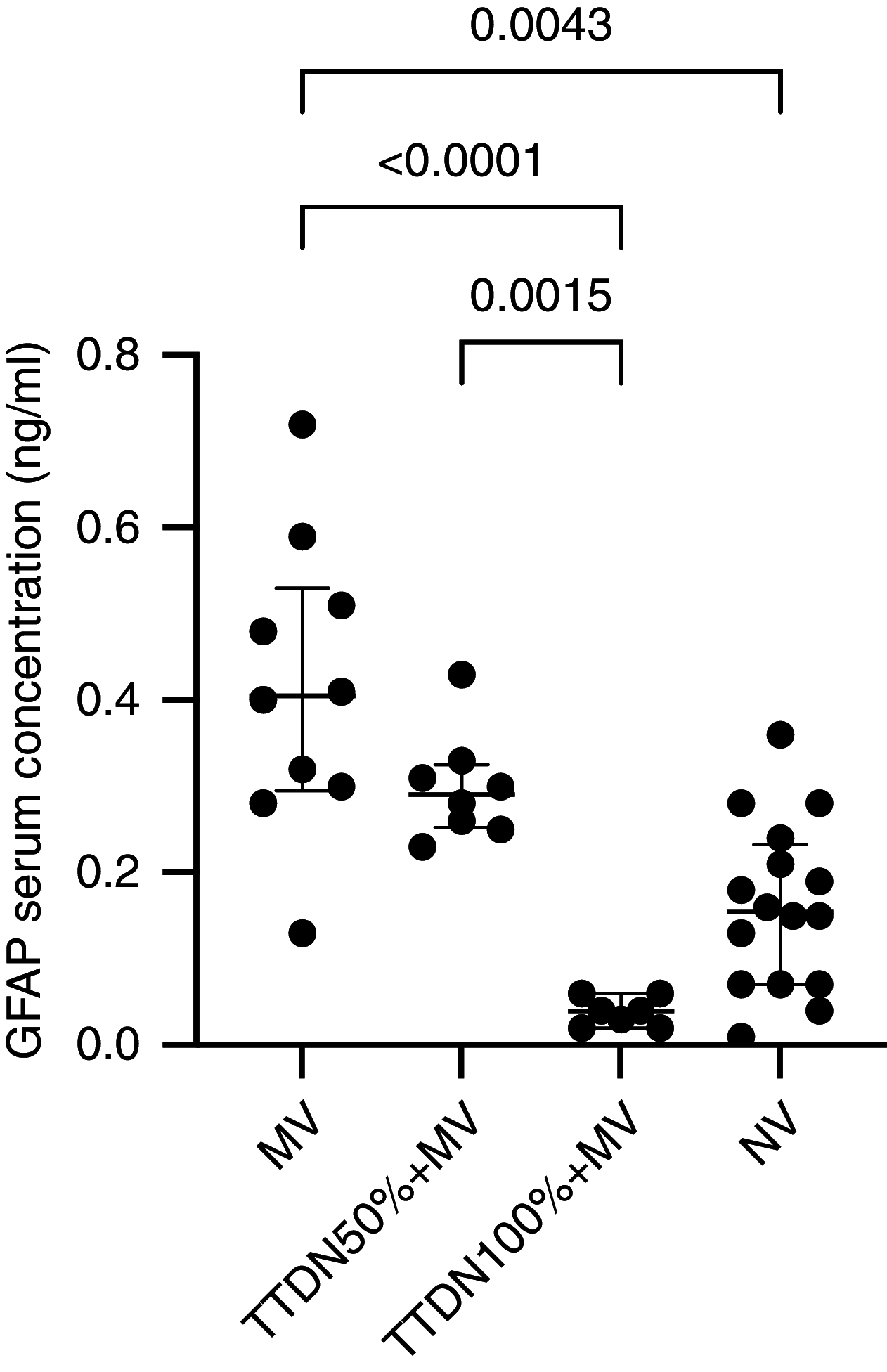Transvenous Diaphragm Neurostimulation Mitigates Ventilation-associated Brain Injury
- PMID: 34491883
- PMCID: PMC8865722
- DOI: 10.1164/rccm.202101-0076OC
Transvenous Diaphragm Neurostimulation Mitigates Ventilation-associated Brain Injury
Abstract
Rationale: Mechanical ventilation (MV) is associated with hippocampal apoptosis and inflammation, and it is important to study strategies to mitigate them. Objectives: To explore whether temporary transvenous diaphragm neurostimulation (TTDN) in association with MV mitigates hippocampal apoptosis and inflammation after 50 hours of MV. Methods: Normal-lung porcine study comparing apoptotic index, inflammatory markers, and neurological-damage serum markers between never-ventilated subjects, subjects undergoing 50 hours of MV plus either TTDN every other breath or every breath, and subjects undergoing 50 hours of MV (MV group). MV settings in volume control were Vt of 8 ml/kg, and positive end-expiratory pressure of 5 cm H2O. Measurements and Main Results: Apoptotic indices, microglia percentages, and reactive astrocyte percentages were greater in the MV group in comparison with the other groups (P < 0.05). Transpulmonary pressure at baseline and at study end were both lower in the group receiving TTDN every breath, but lung injury scores and systemic inflammatory markers were not different between the groups. Serum concentrations of four neurological-damage markers were lower in the group receiving TTDN every breath than in the MV group (P < 0.05). Heart rate variability declined significantly in the MV group and increased significantly in both TTDN groups over the course of the experiments. Conclusions: Our study found that mechanical ventilation is associated with hippocampal apoptosis and inflammation, independent of lung injury and systemic inflammation. Also, in a porcine model, TTDN results in neuroprotection after 50 hours, and the degree of neuroprotection increases with greater exposure to TTDN.
Keywords: ICU; apoptosis; brain injuries; mechanical ventilators; post-ICU syndrome.
Figures





Comment in
-
Reducing Ventilator-associated Brain Injury by Diaphragm Neurostimulation: Racking the Diaphragm to Protect the Brain?Am J Respir Crit Care Med. 2021 Dec 15;204(12):1355-1357. doi: 10.1164/rccm.202110-2312ED. Am J Respir Crit Care Med. 2021. PMID: 34672876 Free PMC article. No abstract available.
-
Stimulating Neural Pathways to Reduce Mechanical Ventilation-associated Neurocognitive Dysfunction.Am J Respir Crit Care Med. 2022 Mar 1;205(5):588-589. doi: 10.1164/rccm.202110-2419LE. Am J Respir Crit Care Med. 2022. PMID: 34978957 Free PMC article. No abstract available.
-
Reply to Salimi et al.: Stimulating Neural Pathways to Reduce Mechanical Ventilation-associated Neurocognitive Dysfunction.Am J Respir Crit Care Med. 2022 Mar 1;205(5):589-590. doi: 10.1164/rccm.202111-2512LE. Am J Respir Crit Care Med. 2022. PMID: 34978976 Free PMC article. No abstract available.
References
-
- Goligher EC, Ferguson ND, Brochard LJ. Clinical challenges in mechanical ventilation. Lancet . 2016;387:1856–1866. - PubMed
-
- Reynolds SC, Meyyappan R, Thakkar V, Tran BD, Nolette MA, Sadarangani G, et al. Mitigation of ventilator-induced diaphragm atrophy by transvenous phrenic nerve stimulation. Am J Respir Crit Care Med . 2017;195:339–348. - PubMed
-
- González-López A, López-Alonso I, Aguirre A, Amado-Rodríguez L, Batalla-Solís E, Astudillo A, et al. Mechanical ventilation triggers hippocampal apoptosis by vagal and dopaminergic pathways. Am J Respir Crit Care Med . 2013;188:693–702. - PubMed
Publication types
MeSH terms
LinkOut - more resources
Full Text Sources
Other Literature Sources
Medical

